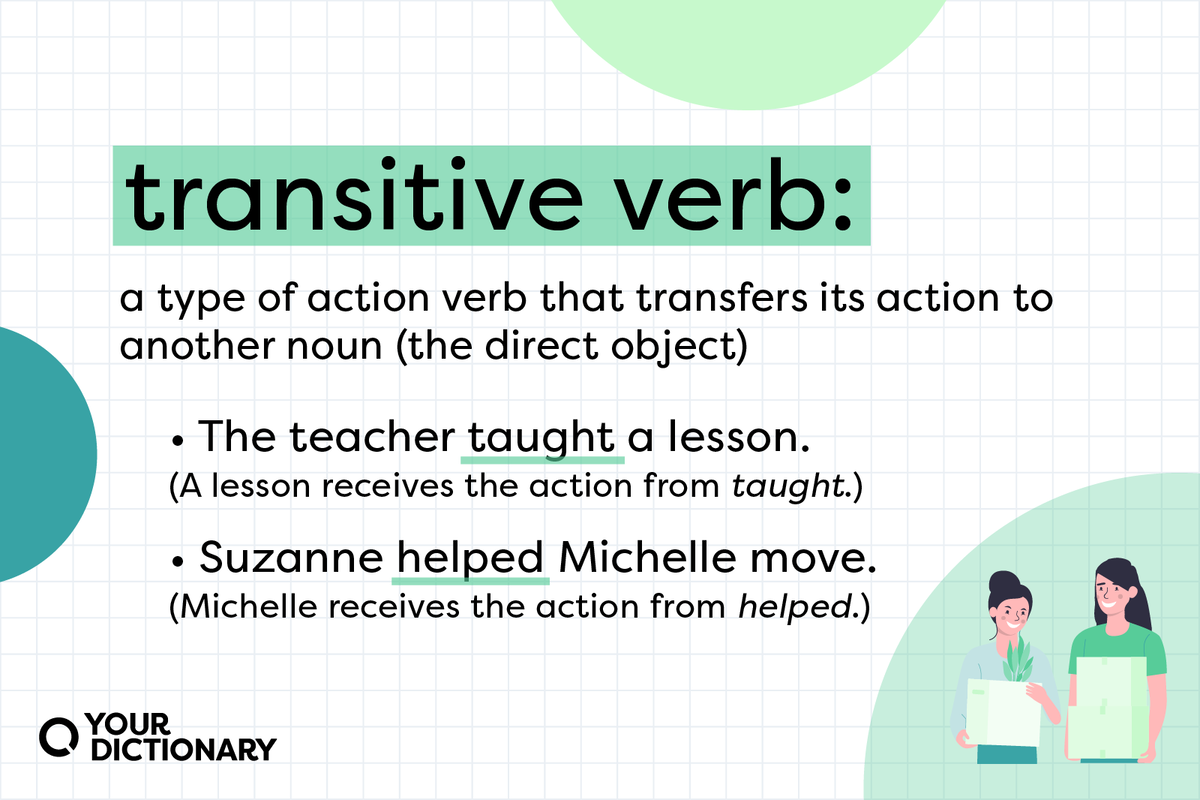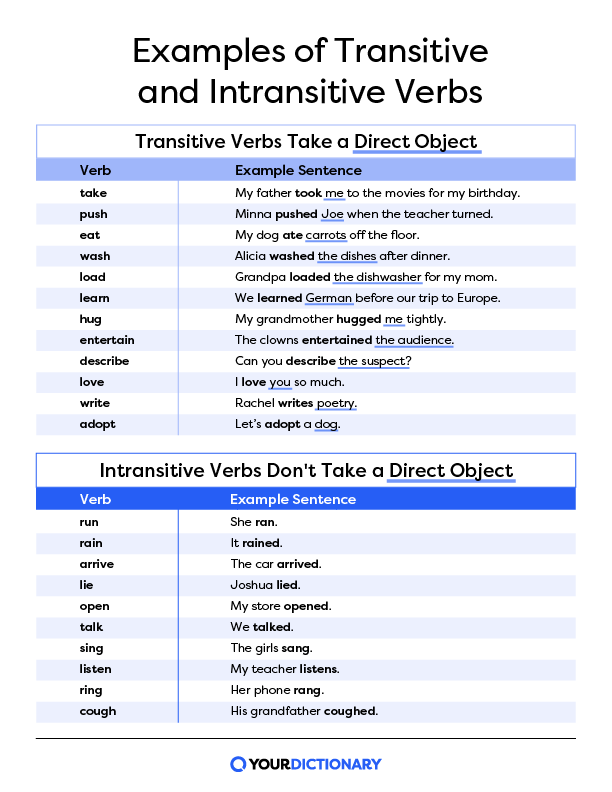
Why can you say “Lilith gets a dollar” but not just “Lilith gets”? Why is “Mark smiled” an okay sentence, but “Mark smiled me” sounds odd? The difference has to do with transitive verbs and intransitive verbs — and it’s a lot less complicated than you think.
What Is a Transitive Verb?
Transitive verbs are a type of action verb that transfer their action to another noun. This second noun is called a direct object, which receives the action from the transitive verb.
- The teacher taught a lesson.
(A lesson receives the action from taught.) - We ordered a plate of nachos.
(A plate of nachos receives the action from ordered.) - Suzanne helped Michelle move.
(Michelle receives the action from helped.) - I met my husband ten years ago.
(My husband receives the action from met.)
Examples of Transitive Verbs
Any verb that can take a direct object is a transitive verb — and transitive verbs always take direct objects.
For example, the sentences “Alex sent” and “Marina put” don’t make sense, because sent and put are both transitive nouns. They need a direct object to make sense. (“Alex sent a postcard” and “Marina put the keys down” sound much better.)
More examples of transitive verbs include:
- My father took me to the movies for my birthday.
- Minna pushed Joe when the teacher turned.
- My dog ate carrots off the floor.
- Alicia washed the dishes after dinner.
- Grandpa loaded the dishwasher for my mom.
- The cat caught the mouse before we could stop her.
- We learned German before our trip to Europe.
- My grandmother hugged me tightly.
- The clowns entertained the audience.
- Can you describe the suspect?
- I love you so much.
- We researched marine life before writing our report.
- Did we surprise Dad?
- I bought a car with my first paycheck.
- Rachel writes poetry.
- Let’s adopt a dog.
A sentence with a transitive verb may also have an indirect object — a noun that receives the direct object. The indirect object might appear between the transitive verb and the direct object (as in “Let’s adopt Joey a dog” or “Rachel wrote me a letter”), but the verb is still transitive in these cases.
Transitive Verbs With Adjectives
You can add an adjective or modifier to the direct object, and the verb in the sentence is still transitive.
- Did we surprise your dad?
- I bought a new car with my first paycheck.
- Rachel wrote beautiful poetry.
- Let’s adopt two dogs.
Transitive vs. Intransitive Verbs
If a sentence doesn’t have a direct object at all, it’s an intransitive verb — a verb that does not transfer its action to a noun. Examples of intransitive verbs include:
- Mark smiled.
- Taylor lived.
- I agree.
- The professor talked.
Intransitive verbs might come before prepositional phrases or adverbs, but they don’t come before direct objects. That’s how you know they’re intransitive.
- Mark smiled at his girlfriend.
(At his girlfriend is a prepositional phrase, not an object) - Taylor lived in New York City.
- The professor talked quickly.
(Quickly is an adverb, not an object) - I agree completely.
(Completely is an adverb, not an object)

Can Transitive Verbs Also Be Intransitive?
Some verbs can only be transitive (such as get, borrow, or bring), while some verbs can only be intransitive (such as cry, live, and laugh). But many verbs can actually be both transitive and intransitive — depending on their context.
- Transitive - She left the books on the table.
- Intransitive - She left at 6:00.
- Transitive - Delia walked the dog to the park.
- Intransitive - Delia walked to the park.
- Transitive - I play the piano.
- Intransitive - I play outside.
- Transitive - The class read a new book this afternoon.
- Intransitive - The class read this afternoon.
Tip for Remembering Transitive Verbs
The key to remembering transitive verbs is in the word transitive — specifically, its prefix trans, which means “extending across.” The action from a verb extends across the sentence, stretching from the verb to the direct object.
You can always test for a direct object by asking “What?” or “Whom?” after the verb. If there’s an answer, it’s a transitive verb.
- She carried the bag home.
(Carried what? The bag — so carried is transitive.) - After the presentation, Joseph thanked Tatyana.
(Thanked whom? Tatyana — so thanked is transitive.) - My train arrived late.
(You can’t ask arrived what or arrived who — so arrived is intransitive.) - The track team jogged down the street.
(You can’t ask jogged what or jogged who — so jogged is intransitive.)

What Is a Linking Verb?